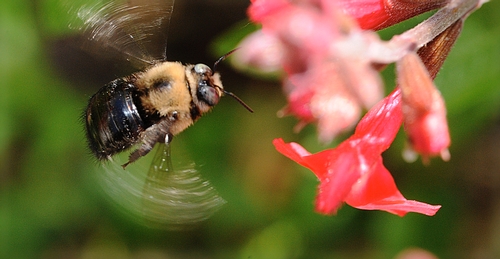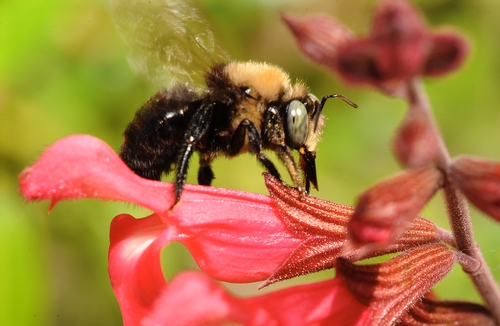Aug 4, 2010
Carpenter bees, which to the uninitiated look like bumble bees, are nice to have around the garden.
Maybe not so nice to have around your untreated patio or fences (as they drill holls in them to make their nests) but just think of them as pollinators, not pests.
As native pollinator specialist Robbin Thorp, emeritus professor of entomology at UC Davis, says: "Carpenter bees are beneficial in that they pollinate flowers in native plant communities and gardens. That far outweighs any damage to wood structures.”
Yes!
She inquired: "I had a couple of female bees (Xylocopa varipuncta) visit my garden this summer, but they seemed only interested in Salvia apiana and citrus flowers. Do you have any idea of other flowers that might interest them (I would like to keep them around longer)? Prefer California native plants."
Thorp responded: "Xylocopa varipuncta is a generalist flower visitor and has been recorded from a number of different kinds of flowers. Some natives you might consider include: Asclepias, Salvia, Trichostema, and Wislizenia for nectar; Eschscholzia and Lupinus for pollen.
Asclepias? The milkweeds. Salvia? Sages. Trichostema? The culinary herbs such as basil, mint, rosemary, oregano, lavender, and thyme. Wislizenia? Think Wislizenia refracta, also called by its common name, jackass clover. Eschscholzia? California poppies. Lupinus? Lupines.
In our yard, carpenter bees are partial to a variety of native and non-native plants, including salvia, lavender, catmint, rock purslane, purple oregano and African blue basil. They also like the golden day lilies and poppies.
Maybe not so nice to have around your untreated patio or fences (as they drill holls in them to make their nests) but just think of them as pollinators, not pests.
As native pollinator specialist Robbin Thorp, emeritus professor of entomology at UC Davis, says: "Carpenter bees are beneficial in that they pollinate flowers in native plant communities and gardens. That far outweighs any damage to wood structures.”
We receive many calls and emails about carpenter bees. Many folks just want to know "what that loud buzz is" or "what's sharing our garden."
The other day we received an email from a carpenter bee enthusiast in Patterson who wanted to know how to keep attracting them to her garden.Yes!
She inquired: "I had a couple of female bees (Xylocopa varipuncta) visit my garden this summer, but they seemed only interested in Salvia apiana and citrus flowers. Do you have any idea of other flowers that might interest them (I would like to keep them around longer)? Prefer California native plants."
Thorp responded: "Xylocopa varipuncta is a generalist flower visitor and has been recorded from a number of different kinds of flowers. Some natives you might consider include: Asclepias, Salvia, Trichostema, and Wislizenia for nectar; Eschscholzia and Lupinus for pollen.
Asclepias? The milkweeds. Salvia? Sages. Trichostema? The culinary herbs such as basil, mint, rosemary, oregano, lavender, and thyme. Wislizenia? Think Wislizenia refracta, also called by its common name, jackass clover. Eschscholzia? California poppies. Lupinus? Lupines.
In our yard, carpenter bees are partial to a variety of native and non-native plants, including salvia, lavender, catmint, rock purslane, purple oregano and African blue basil. They also like the golden day lilies and poppies.
Attached Images:

Dead Aim

Piercing the Corolla

On Rock Purslane